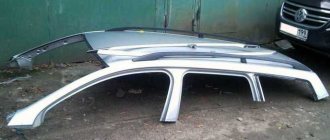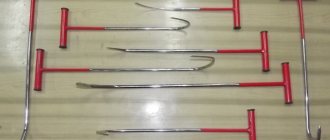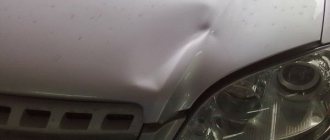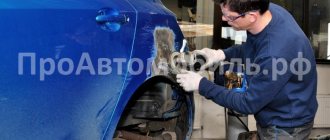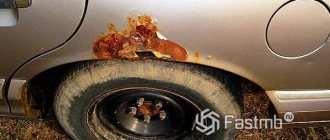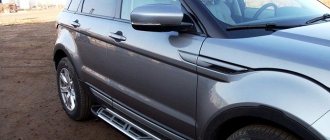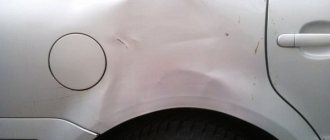What causes dents on the roof of a car?
Few people know, but the thickness of the skin of an aircraft used for civil aviation is only 0.5 mm. In some places the thickness of the cladding is about 6 mm. The thickness of the body of a regular passenger car, like that of an airplane, is about 0.5 mm. That is why the car body easily lends itself to any even slight deformation.
As a rule, the easiest way to deform the body of a car is as follows:
- lean heavily on the hood or roof;
- get a dent on the hood from being hit by a stone or other massive object;
- collide with another car;
- get into a serious accident;
- suffer from the illegal actions of others;
- fail to park and crash into something.
If the deformation is minor and is not accompanied by additional damage to the body and internal contents of the car, then you can get by with simple repairs and level out the dent on the roof or any other place without using painting.
door dent repair without painting
If the damage is more serious - an accident, the part has been “ground in” and the geometry is broken, then in this case, in order to repair the dent on the door without painting, you may need to remove the trim or completely disassemble it.
There are also areas on the door where repairing damage to the factory geometry is only possible on a special stand. Only then will the technician be able to efficiently remove dents on car doors using PDR technology and the vacuumization method.
Repairing car door dents becomes more difficult if the area to be repaired is located on a stiffener, bend or reinforcement. Aluminum alloys complicate the repair of dents on the door and increase its time - such metals are less willing to be pulled out.
Without professional training in such a situation, it is not recommended to repair a door dent on your own, otherwise the cost of correcting the defect can result in a substantial amount. Even a small dent on a car door requires precise calculation of effort and pressure; besides, the price of repairs in our technical center is one of the most affordable services on the market. Our craftsmen will perform abrasive cleaning and polishing of the damaged area, and can also carry out detailing, giving the car a glossy shine, like from a showroom.
How to remove a dent on a door?
Some car owners, without trying to find out how much it costs to repair a dent on a door, begin to perform this procedure on their own, using various devices. As a result of inept actions, the paint layer is damaged, and then serious measures for its restoration and painting work cannot be done, and this will have to be done in the workshop.
Our company is a supporter of innovative technologies and high-quality customer service, therefore we have the most affordable price for paintless dent removal on doors and various segments of the car body. Therefore, you should weigh the pros and cons, even if the dent on the car door is small and the cost of repair seems somewhat high to you.
You can avoid many problems if you call our managers and find out how much it costs to repair a dent on the door of a VAZ car that has a small or large dent.
Most often, this problem arises among car owners who have an inexpensive car, especially since there are many options online for repair work on preparing and leveling the surface, eliminating defects using magnets, various tools and a hair dryer. Many have definitely already become familiar with these methods. But, before resorting to them, without having experience in straightening, you should take into account that later you may need to repair the dent on the door with painting, due to the resulting chips and cracks.
On newer vehicles, DIY alignment errors will be more costly than having a professional door dent repair technician do the job.
Our experts also use the glue method, mini-lifter, special hooks, and vacuum suction cup. Repairing a car door dent caused by a stone depends on the specific damage. Our company’s policy is to protect car owners from rash steps, so we do not want to give advice so that later repairs and anti-corrosion treatment do not cost you more.
What is local auto repair?
Local repairs are considered to be any technical work performed on any individual part of the body, which requires either partial painting or no painting at all. Such repairs are always distinguished by their cheapness and the speed of restoring the car to its normal appearance. Also, local repairs do not require dismantling the body or using large tools, which is why it is most preferable for such parts as car roofs and rear fenders.
Such repairs are used only to restore damage such as:
- scratches;
- dents;
- abrasions.
Important!
If, if even minor dents are found on the roof or hood of the car, they tell you that it is necessary to completely replace the body part, look for another car dealership. As a rule, almost any deformation of the body, characterized by minor damage, does not require complete replacement and expensive repairs.
Always coordinate any resulting defect with the insurance company, and only then go to the salon. Often, even when repairing the smallest abrasions, people try to get much more money than they actually need. Therefore, it is important to understand the correct course of repair work, understand the degree of damage to the body, and know the necessary measures to eliminate the acquired consequences.
Advantages of ordering car body dent repair services in Moscow from us
We carry out body repair work of any complexity at the best prices. Service specialists will remove damage of various sizes, origins and depths. When removing dents, we guarantee complete restoration of the body configuration to the parameters it had after factory assembly. In addition, complete visual invisibility of the damaged area is guaranteed.
We always provide a guarantee:
- high speed of any work, regardless of complexity;
- exceptional quality of car dent repair;
- favorable price;
- complete restoration of geometry.
What dents can be fixed without painting?
In order to understand whether you will have to paint the body or not, you need to figure out which dents can be straightened out without subsequent painting. For example, if it is steel, then the methods for dealing with deformation will be completely different than for the same damage on a plastic or aluminum panel. This is due to the fact that aluminum does not remember the properties of the original shape of the metal, so the option of making repairs without painting will not work here.
The methods for straightening a dent will also differ from each other. For example, one of the most common ways to remove a dent from the hood or roof of a car is to pull it out using a vacuum. The stretching will also vary depending on the nature of the original material, which will ultimately affect the need to paint the damaged element or do without painting.
Important!
In addition to the original nature of the material, it is important to understand exactly what deformation occurred. It is much easier to straighten a dent on the roof, hood or any other part of the body if it does not have plastic deformation. In such cases, the metal itself does not change; normal displacement occurs. During repair, the damaged part is simply put back in place, after which the memory acquired during production independently restores its original shape.
In cases where the damage is near the edge, straightening out a dent on the roof, hood or other damaged area becomes even more difficult. This is due to the increased rigidity of the edge metal. Therefore, it is important to assess the state of the deformation, the location of its occurrence, and the nature of the resulting damage.
Removing dents without painting
If there is no damage to the paintwork on the roof, you can easily do without painting, which significantly reduces the overall cost of restoration work. The most popular repair option is the PDR (Paintless Dent Repair) method, developed about two decades ago by engineers of the famous Mercedes-Benz concern. It was originally used in factories to eliminate defects caused by assembly lines, but today it is used everywhere and is considered the most effective way to eliminate problems.
Before you figure out how to straighten dents on a car roof using PDR, you should take into account that this technique involves the use of special vacuum suction cups, through which the problem area is pulled back to its original position. The advantage of this method is that after repair it is almost impossible to detect the location of the defect, and restoration is carried out without significant investment. Damage repair is carried out according to the following algorithm:
- Preparing the roof for work by washing out damage and cleaning the area around the dent.
- Apply the suction cup to the damaged area and carefully fix it.
- Pumping out air from the cavity formed between the surface of the car and the tool itself.
- Smoothly press the suction cup in the required direction. During operation, it will pull the metal behind it and return it to its original place.
Removing dents using the PDR method leaves the car's factory paint intact, which is especially important in cases where the car is being prepared for sale. The method is used not only to restore the roof, but also to repair any other body elements - wings, trunk, hood, side surfaces. It is worth noting that vacuum suction cups are not always suitable for the job. If the damage is too deep or large, they may be useless, so sometimes several more methods of eliminating defects are used:
- Using a construction hair dryer, a stream of hot air is directed at the damaged area, and then cold air is turned on, which allows you to remove the damage due to the temperature difference.
- Using levers and hooks, the tool is inserted into the most convenient technical hole of the vehicle, the dent is “groped” and, gradually increasing the pressure, squeezes it out.
If you don't know how to fix dents correctly and effectively, the smartest thing to do is to seek professional help. Motorists living in Moscow and the region can take advantage of a company that specializes in repairing Land Rover, Range Rover and Jaguar cars. Our service technicians have extensive experience in restoring vehicles and will quickly fix any problems at a competitive price.
How to correct a dent?
As mentioned earlier, a body panel stamped at the factory has a memory, thanks to which it is able to restore its original state. All that is required for this is to relieve the stress of the metal, giving it a certain plasticity.
Next, the deformed dent is pulled out. This should be done as quickly as possible due to the rapid decrease in the plastic properties of the metal. If you tighten it with stretching, you can get a mark on the body left from the previously obtained deformation.
During straightening, special attention should be paid to deformed edges, since when a dent is formed, the edges around it also rise. This is important, because at the time of pulling, it is important to tap each centimeter of the raised edge one by one in order to remove all the consequences as evenly as possible.
Advice!
If the concavity turns out smooth, the paint along the contour has not peeled off, no folds have formed, you can tap with your hand, straightening the contours. But this should be done very carefully to prevent even greater damage.
It is best to carry out such work with heated metal, since when exposed to elevated temperatures, its plastic properties increase. Consequently, any defects are easier to correct. As a general rule, the larger the crack, dent or scuff, the higher the heating temperature should be. This is necessary to increase the elasticity of the material and reduce the pressure exerted on the resulting dents.
If you do the straightening yourself, you can use a home hair dryer. It will not have a strong impact, but it can simplify the process of pulling out a dent. If a special construction hair dryer is used for repairs, then you should be extremely careful not to slow down in one place. Even the slightest delay can cause even more cracking of the paint, if it already exists. Also, a hair dryer can contribute to the formation of deep cracks in the paint if there were none before. Therefore, it is important to use it at a distance of at least 10 cm from the surface of the car in order to prevent even greater deformation on the surface of the body.
DIY methods for straightening dents
In cases of even minor damage, it is best to contact experienced specialists who will return the car to proper condition within a short period of time. But if this is not possible, then we will list several ways to get rid of a dent yourself using improvised means.
Advice!
Do not try to repair a car if you do not have the proper experience and do not understand the details.
This way you risk only worsening existing damage.
- straightening from the back of the panel;
- heating and subsequent cooling for repairs;
- method of straightening dents using a vacuum cleaner;
- using a hot glue gun and pull-out elements;
- pulling out the dent with a plumbing plunger;
- method of straightening dents using a ball;
- removing dents on the door using hooks and levers;
- repairing dents using a jack;
- removing dents on a car using a reverse hammer.
How is dent removal done from a car body with or without painting?
Our specialists will conduct a thorough diagnosis of the damaged area using special equipment. They will determine which dent repair method will be most effective in this particular case. When the method is selected, the area is localized, the surface is degreased and pre-treated. To pull out dents, special suction cups and hooks are used, which allow you to completely restore the damaged area without noticeable consequences and the use of traditional putty.
It is also possible to remove dents from a car body using a special technology for pulling metal without painting with a suction cup - PDR (Paintless Dent Repair). This is a conceptually new method that has been used in Russia relatively recently. Our specialists have been trained and have significant experience in this area.
The technology of PDR repair of dents on a car (without painting) involves several stages:
- preparatory - special hot-melt adhesive is applied to the surface of the area, onto which pistons of different shapes are fixed depending on the configuration of the damage;
- stretching the total area;
- exposure from the inside - for this, special technological holes are drilled (if there is no access through the removed interior trim), with the help of which the area is brought to its original condition;
- finishing with cores from the inside for the most accurate finishing;
- local polishing.
The method has proven itself to be effective in removing dents on fenders, doors, sills, hood, trunk and bumpers. To stretch the area, special vacuum suction cups are used, the operation of which is based on the principle of molecular memory of the metal. In addition, paintless technology allows work to be carried out much faster - within 1-4 hours.
